Opium Poppy Cultivation, by John W. Allen
After the petals drop from the flowers, pods will remain on the stalks. These capsules will grow in size for the next few days. In five to ten days after the petals fall, the plant is ready for harvest. The opium is concentrated in the skins of the unripe pods.
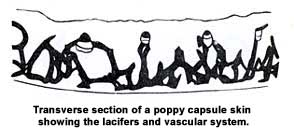
The most common method of extraction is to make shallow incisions around the center of the pod. The time of harvest is critical. If the capsule is slit too soon, the opium will be too watery to collect, and if too late, the alkaloid level will drop. Test incisions can be made at 24 hour intervals. When the latex (or juice) becomes thick enough that it does not run down the pod, the time is right. Another clue to the correct time for harvest is that the leaves will turn slightly yellow.
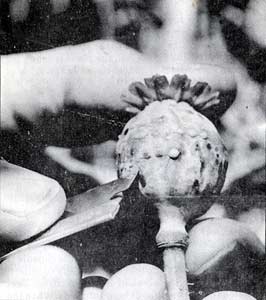 The cuts may be made in the morning, just after the dew has evaporated or in the evening before sunset if no morning dew is expected.
The cuts may be made in the morning, just after the dew has evaporated or in the evening before sunset if no morning dew is expected.
Rain or dew will wash away the latex so you should hold off on harvest if the weather does not look promising. Make shallow incisions around the entire circumference of the pod.
Do not cut below the level of the skin, for if the slits are made into the capsule itself, much opium will flow into the seed chamber and be lost.
Immediately after cutting, milky liquid opium will form droplets around the incision. It will coagulate slowly from contact with the air, thickening and turning brown at the same time. Generally, this liquid opium is allowed to dry for ten or twelve hours before it is scraped from the pod. If you can't wait, go ahead and lick some directly off the capsules. Don't get carried away though, or you may end up face down in your field.
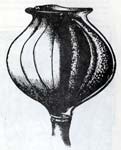 The instrument used for scraping the opium from the pods varies from culture to culture, but is usually some sort of thin metal blade. A small metal spatula works well but a butter knife will do.
The instrument used for scraping the opium from the pods varies from culture to culture, but is usually some sort of thin metal blade. A small metal spatula works well but a butter knife will do.
Hold the capsule firmly between thumb and forefinger and draw the scraper upward along the pod's surface. Practice makes perfect.
As the raw opium collects on the scraping device, it is removed and placed in an open container so that it may dry further. When it reaches the consistency of hashish, it is ready for storage, or whatever one wishes to do with opium.
Opium darkens with age and eventually it becomes almost black.
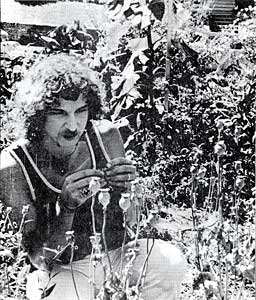
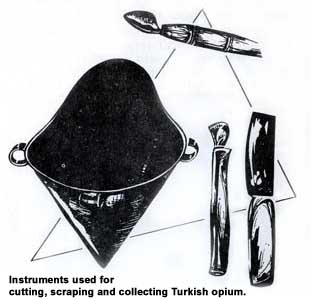
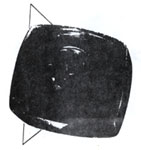 The pod may be incised again every few days, as long as it continues to yield juice. The morphine content of the opium will, however, decrease with repeated lancings. Raw opium will contain from 8 to 15% morphine as well as codeine and related alkaloids. If you wish to speed up the drying process, the raw product may be thickened by heating, to drive off excess moisture.
The pod may be incised again every few days, as long as it continues to yield juice. The morphine content of the opium will, however, decrease with repeated lancings. Raw opium will contain from 8 to 15% morphine as well as codeine and related alkaloids. If you wish to speed up the drying process, the raw product may be thickened by heating, to drive off excess moisture.
The dried plants may be saved and used to make a pleasant and effective tea. Dried opium poppies are referred to as "poppy straw." Poppy straw may be subjected to an extraction process, utilizing ether, and will produce opium directly from the dried plants. This is much the same method by which hash oil is derived from marijuana.
Alcohol could also be used, although not as effectively. Do not attempt to perform extractions yourself unless you have done the necessary research, since explosions or fires are possible without suitable precaution.
[ Back ] [ Index ] [ Next ]
© 2000 John W. Allen & Erowid.org

 The cuts may be made in the morning, just after the dew has evaporated or in the evening before sunset if no morning dew is expected.
The cuts may be made in the morning, just after the dew has evaporated or in the evening before sunset if no morning dew is expected.Rain or dew will wash away the latex so you should hold off on harvest if the weather does not look promising. Make shallow incisions around the entire circumference of the pod.
Do not cut below the level of the skin, for if the slits are made into the capsule itself, much opium will flow into the seed chamber and be lost.
Immediately after cutting, milky liquid opium will form droplets around the incision. It will coagulate slowly from contact with the air, thickening and turning brown at the same time. Generally, this liquid opium is allowed to dry for ten or twelve hours before it is scraped from the pod. If you can't wait, go ahead and lick some directly off the capsules. Don't get carried away though, or you may end up face down in your field.
 The instrument used for scraping the opium from the pods varies from culture to culture, but is usually some sort of thin metal blade. A small metal spatula works well but a butter knife will do.
The instrument used for scraping the opium from the pods varies from culture to culture, but is usually some sort of thin metal blade. A small metal spatula works well but a butter knife will do.Hold the capsule firmly between thumb and forefinger and draw the scraper upward along the pod's surface. Practice makes perfect.
As the raw opium collects on the scraping device, it is removed and placed in an open container so that it may dry further. When it reaches the consistency of hashish, it is ready for storage, or whatever one wishes to do with opium.
Opium darkens with age and eventually it becomes almost black.


 The pod may be incised again every few days, as long as it continues to yield juice. The morphine content of the opium will, however, decrease with repeated lancings. Raw opium will contain from 8 to 15% morphine as well as codeine and related alkaloids. If you wish to speed up the drying process, the raw product may be thickened by heating, to drive off excess moisture.
The pod may be incised again every few days, as long as it continues to yield juice. The morphine content of the opium will, however, decrease with repeated lancings. Raw opium will contain from 8 to 15% morphine as well as codeine and related alkaloids. If you wish to speed up the drying process, the raw product may be thickened by heating, to drive off excess moisture.The dried plants may be saved and used to make a pleasant and effective tea. Dried opium poppies are referred to as "poppy straw." Poppy straw may be subjected to an extraction process, utilizing ether, and will produce opium directly from the dried plants. This is much the same method by which hash oil is derived from marijuana.
Alcohol could also be used, although not as effectively. Do not attempt to perform extractions yourself unless you have done the necessary research, since explosions or fires are possible without suitable precaution.
© 2000 John W. Allen & Erowid.org

